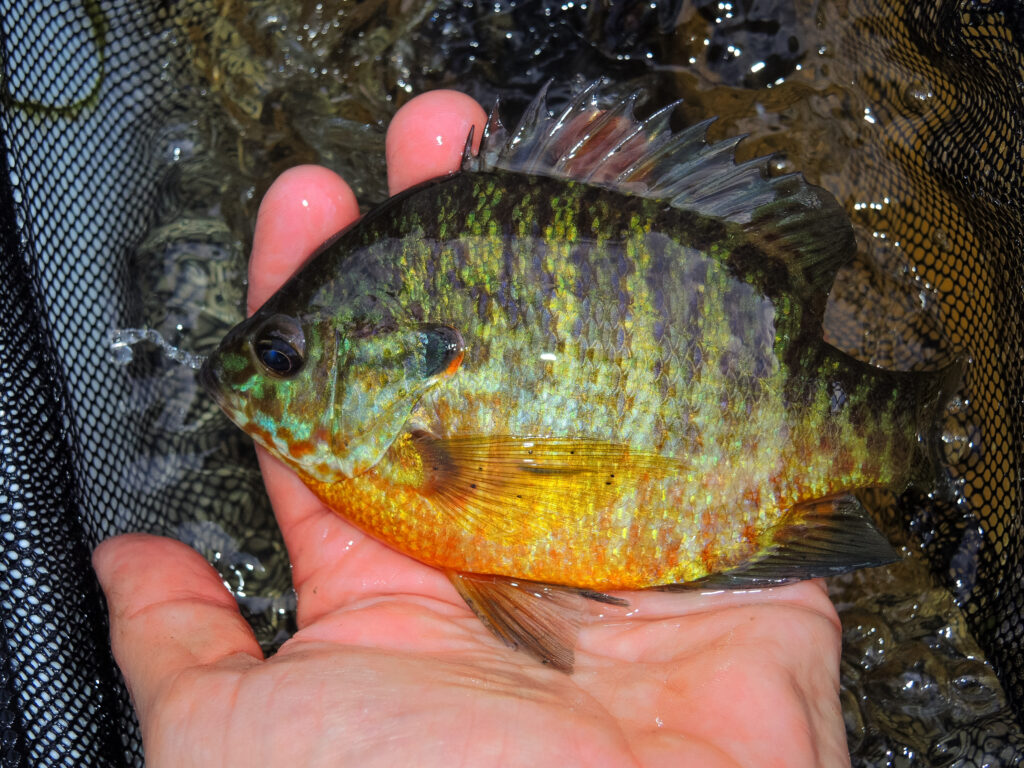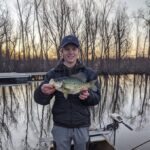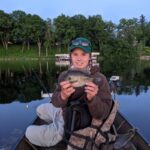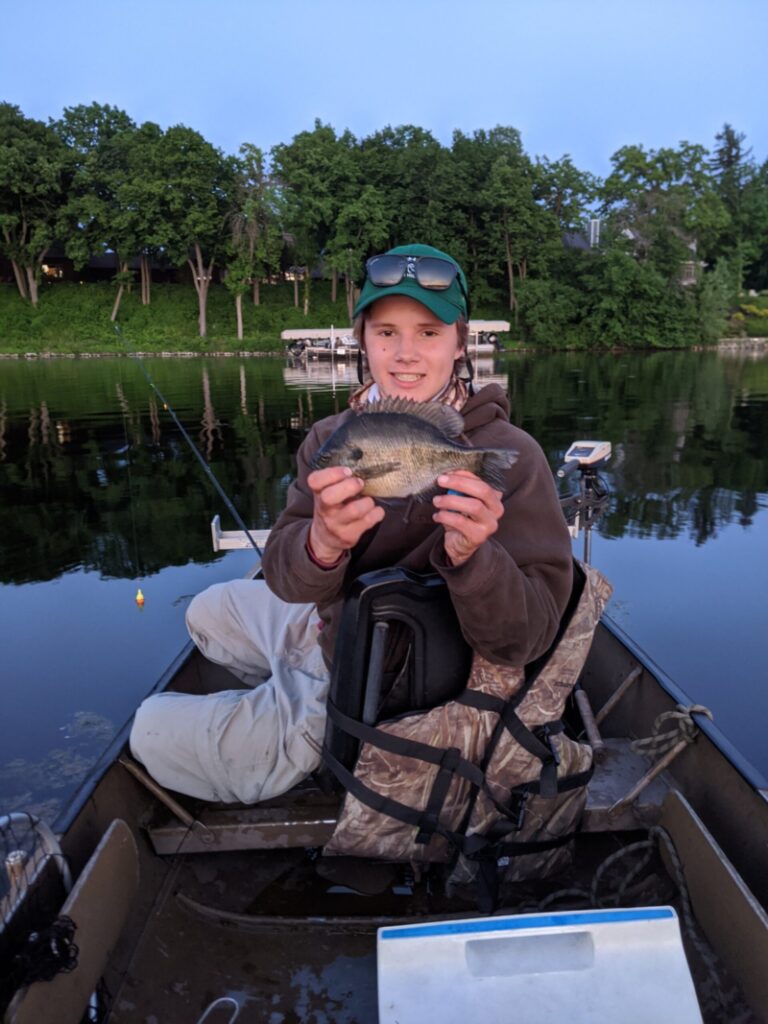Hey there, fellow anglers! When the bite gets tough in the summer, targeting panfish is a great way to pass the time. Panfish are not just a great opportunity for beginner anglers, but provide opportunity for advanced anglers as well. As a fisherman who’s had my fair share of summer panfish adventures, I’m excited to share everything you need to know for the next time you head out on the water. As always, fishing education and conservation are our priorities here at The Angler’s Line. Feel free to sign up for our free newsletter to join our community and stay up to date! So, let’s dive in and discover the best tips, gear, and techniques for summer panfish!
Table of Contents:
Understanding Panfish
What are Panfish and Their Common Species
First things first, let’s get to know our scaly targets – panfish! The panfish category includes bluegill, crappie, perch, and more. Each of these species have their own nuances, but a lot of their preferences are similar. They might be small in size, but boy, can they put up a fight!
Summer Migration
In the spring, panfish are shallow. When the water temperature increases and the days get longer, panfish seek deeper water or structure. They can still be found in shallow water, but access to deep water is critical in the summertime. Instead of being in the back of a bay or channel like they were in spring, they are more likely to congregate around a drop off near the lakes basin. This is a general rule of thumb, but I’ll go more in depth into summertime panfish location later on in the article.
Essential Gear and Tackle
By no means do you need specialized equipment for panfish when you are first getting started, but having the correct gear as you get more advanced can be advantageous for panfish.
Choosing the Right Fishing Rod and Reel
For panfish, a lightweight fishing rod and reel setup works best. This allows you to cast the light lures necessary and feel the subtle bites. I prefer an ultralight spinning rod between 6 and 6.5 feet in length. As far as reels go, a size 500 or size 1000 spinning reel is ideal for fishing panfish. Like I said before, use what you have if you are just getting started. Eventually, a more specialized rod and reel is a good investment down the line.
Fishing Lines and Their Strengths
When fishing for panfish, having a fishing line with a thin diameter is critical. Without a thin line, you are going to experience a lot of headaches trying to cast and effectively fish lightweight lures. I recommend choosing a line between 4 lb and 6 lb of test. Fluorocarbon and monofilament lines are the main lines that I use when fishing for panfish. If fishing crystal clear water, fluorocarbon is the way to go do to its low-visibility in the water.
Best Lures For Summer Panfish
As for bait and lures, keep in mind that panfish get more aggressive as water temperatures rise in the summer.
Live Bait
When most people think of panfish fishing, they think of live bait. Panfish generally can’t resist a worm or minnow at any time of year! Make sure to select the panfish live bait for the given species of panfish you will be targeting. Minnows tend to work best for crappies, and worms and insects are best for sunfish species and perch. Use small jigs or split shot rigs to present live bait. If fishing small minnows for crappie, a slip bobber rig can be a great way to go.
Soft Plastics
Soft plastics are often overlooked by panfish anglers, but summer is one of the best times to use them. When water temperatures increase, panfish activity tends to increase as well. This means that panfish are feeding heavily and chasing bait. Soft plastics allow you to fish quicker and more aggressively than live bait which is advantageous this time of year. Some great soft plastic options for summer panfish include grubs, paddle tail swimbaits, and tubes. Remember to choose the smallest soft plastic sizes available to adhere your presentation towards panfish.
Bonus Tip: If you are dealing with a lot of smaller panfish constantly pecking at your live bait rig, switch to soft plastics to prevent rebaiting and tailor your presentation to the larger fish in the school.
Beetle Spins
Beetle Spins are my go to lure when searching for panfish in the summer. For those of you that don’t know, a beetle spin is essentially a spinner bait for panfish, minus the skirt material. This lure is great in the summer time because it has added flash and vibration. Additionally, the wire mold acts as a weed guard which allows you to fish it in and among weeds where panfish like to hide in the summer. Use a steady retrieve with this lure to keep it at the appropriate depth. Don’t be afraid to add an occasional twitch or pause to trigger panfish that may be following.
As always, experiment with different lures and retrieves to find what the panfish want on a given day. Keep in mind that their preferences can change depending on water clarity, barometric pressure, and other weather factors. Don’t hesitate to experiment with different sizes and colors to match the prevalent forage. In stained or murky waters, brighter or contrasting colors can enhance visibility.
Finding Summer Panfish Hotspots
Now that you are equipped with the correct gear, lets talk about where you should start you search for summertime panfish.
Weed Beds
Weed beds are well know locations to fish during the summer. Submergent vegetation produces oxygen and shade, which a lot of fish seek when the water temperatures rise. Panfish often seek weed beds for cover from predators. In the summer, I have found that weed beds that are close to deep water tend to produce the best. Some great places to look are drop offs, points, or humps that have good weeds on top.
Not all weeds are created equal when it comes to panfish. Focus on weeds that grow vertically in the water column. What I mean by that is that a weed bed with weeds growing five feet off of the bottom is likely to be better than sand grass growing within a foot of bottom. Think cover, and find weed beds that panfish have the best chances of hiding in and finding shade.
Hard Cover
First off, when I say hard cover I am talking about all types of cover other than weeds. Docks, bridges, and rafts are all great examples of this. Panfish congregate around this hard cover in the summer for the same reasons they congregate around weeds. Shade and cover. Focus on hard cover areas near the main lake and deeper water. Shallow water can be effective in the summer as deep water is nearby. The backs of shallow bays and channels tend to heat up quickly this time of year, pushing panfish to the main lake areas.
Basin Areas
The basin of a lake refers to its deepest water. Fishing summer panfish in the basin is fairly unique, but I figured it would still be worth mentioning. In some bodies of water, panfish will suspend over the basin when the water temperatures reach their peak. It doesn’t matter if the basin is 30 feet deep or 100 feet deep, these fish are relating to the thermocline. Using your electronics is critical for targeting the basin to determine the depth of the thermocline and to mark fish that are relating to it. Typically a thermocline will appear as a thin line on your depth finder, and you won’t mark much above or below it.
Techniques for Summer Panfish Fishing
Each summer panfish lure requires a slightly different technique to maximize its effectiveness. Here are three good techniques to start with, but don’t be afraid to add your own slight variations to each one.
Bobber Fishing
Bobber fishing is a great technique for presenting live bait when fishing for panfish. Bobbers excel in the summer since it allows you to suspend your bait over the tops of weeds and other cover without getting hung up. When fishing for panfish, be sure to choose a specifically designed panfish bobber. If fishing shallow water (less than 6 feet), use a clip-on bobber set to a fixed depth. For slightly deeper water, a slip-bobber is much more effective. Add a slip-shot and hook beneath your bobber with your choice of live bait. This technique works best when you have already located a school of panfish since it does not cover much water.
Vertical Jigging
Vertical jigging is a technique that I started out with when fishing for panfish in the summer. Once you get the hang of your electronics and can decipher what panfish look like, vertical jigging is an extremely effective way to target them. Simply use a jig or split-shot rig with either live bait or soft plastics, and fish vertically over the side of the boat. This technique works best in deeper water since panfish are less likely to be spooked with your boat over the top of them. Vertically jigging is one of my favorite methods for catching suspended panfish over the basin.
Casting
A great way to cover water and locate panfish in the summer is casting. Cast with beetle spins or soft plastics and constantly stay on the move until you find fish. Incorporate occasional twitches and pauses into your retrieve and constantly experiment. Some days and slow and steady retrieve may be best while other days may require something more aggressive. Once you have located panfish and they stop biting, feel free to switch up to more subtle retrieves like bobbers or vertical jigging to get a few more bites.
Fly Fishing
Fly fishing is a technique that requires practice and patience to get the hang of and is tailored to more advanced anglers. At the same time, I would be doing you a disservice by not mentioning it since fly fishing is extremely effective in the summer. Fly fishing excels for summertime panfish when they are relating to visible cover. This could be a floating raft, dock, or bridge piling. Cast your favorite panfish fly next to this cover and you are likely to see success. Although fly fishing works for all types of panfish, bluegills seem to be the most susceptible to fly fishing in my experience.

Reading the Summer Weather
As the summer weather can be unpredictable, it’s crucial to understand how it affects panfish behavior. Adjust your techniques and bait choices accordingly to adapt to the weather conditions.
Sunny vs. Overcast
On sunny days, you’ll find panfish in the shade typically. In shallow water, they may be sitting underneath a pier or in and amongst the weeds. In the basin, it seems like the opposite happens. Panfish may be more suspended and higher in the water column then usual. Clouds in the summer typically coincide with low barometric pressure. This means that panfish are more inclined to spread out further from cover actively searching for bait.
Wind
The winds in summer can be extremely variable. Some days you may have strong winds before a front, while other days can be glass calm. Heavy winds push baitfish and insects around in the water. Baitfish and insects tend to concentrate on the windward side of structure, and so do the panfish as a result. If it is calm, panfish tend to roam in the summer and won’t be locked on to one piece of cover. Fly fishing is a great technique to use when fishing for panfish in calm conditions.
Sunrise and Sunset: The Magic Hours for Panfish Activity
When fishing the dog days of summer, the middle of the day tends to be the hottest and most uncomfortable for fishing. The panfish feel the same way. Focus your efforts on the low-light periods at sunrise and sunset in the summertime. If you have to fish during the midday, look in deeper water or basin areas. These fish are more inclined to bite when the sun is high.
Conservation and Ethical Fishing Practices
As responsible anglers, it’s crucial to prioritize conservation and practice ethical fishing

Catch and Release
Adhere to catch-and-release guidelines whenever possible to preserve the panfish population for future generations. Handle fish with care, use barbless hooks to minimize injury, and return them to the water as quickly and gently as possible. If you plan on keeping a few fish for a meal, release the larger fish to let them spawn.
Regulations and Limits
Stay informed about local fishing regulations and adhere to size and bag limits. These limits are in place to ensure sustainable fish populations and healthy ecosystems. Ignorance is no excuse, so take the time to familiarize yourself with the specific regulations in the areas you fish.
Leave No Trace
Respect fish and wildlife habitats by minimizing your impact and leaving the environment as pristine as you found it. Dispose of any trash properly and consider participating in organized shoreline cleanups. Respecting nature and its resources is crucial for future generations of anglers to enjoy.
And there you have it! A comprehensive guide to conquering summer panfish fishing. With the right gear, techniques, and understanding of location, you’re all set for your next summer panfish fishing adventure. So, grab your fishing rod, put on your sun hat, and put your newfound knowledge to the test. Remember, it’s not just about catching fish; it’s about connecting with nature, making memories, and cherishing the moments spent by on the water. Happy fishing!
More Panfish Fishing Articles:
- Lure Talk: Best Crappie Lures For Each Season

- Ice Fishing For Crappie: Everything You Need To Know

- Slip Bobber Crappie Fishing: Everything You Need To Know

- Summer Panfish Fishing: Everything You Need To Know

- Ice Fishing For Panfish: Everything You Need To Know

- Fall Panfish Fishing: Everything You Need To Know

